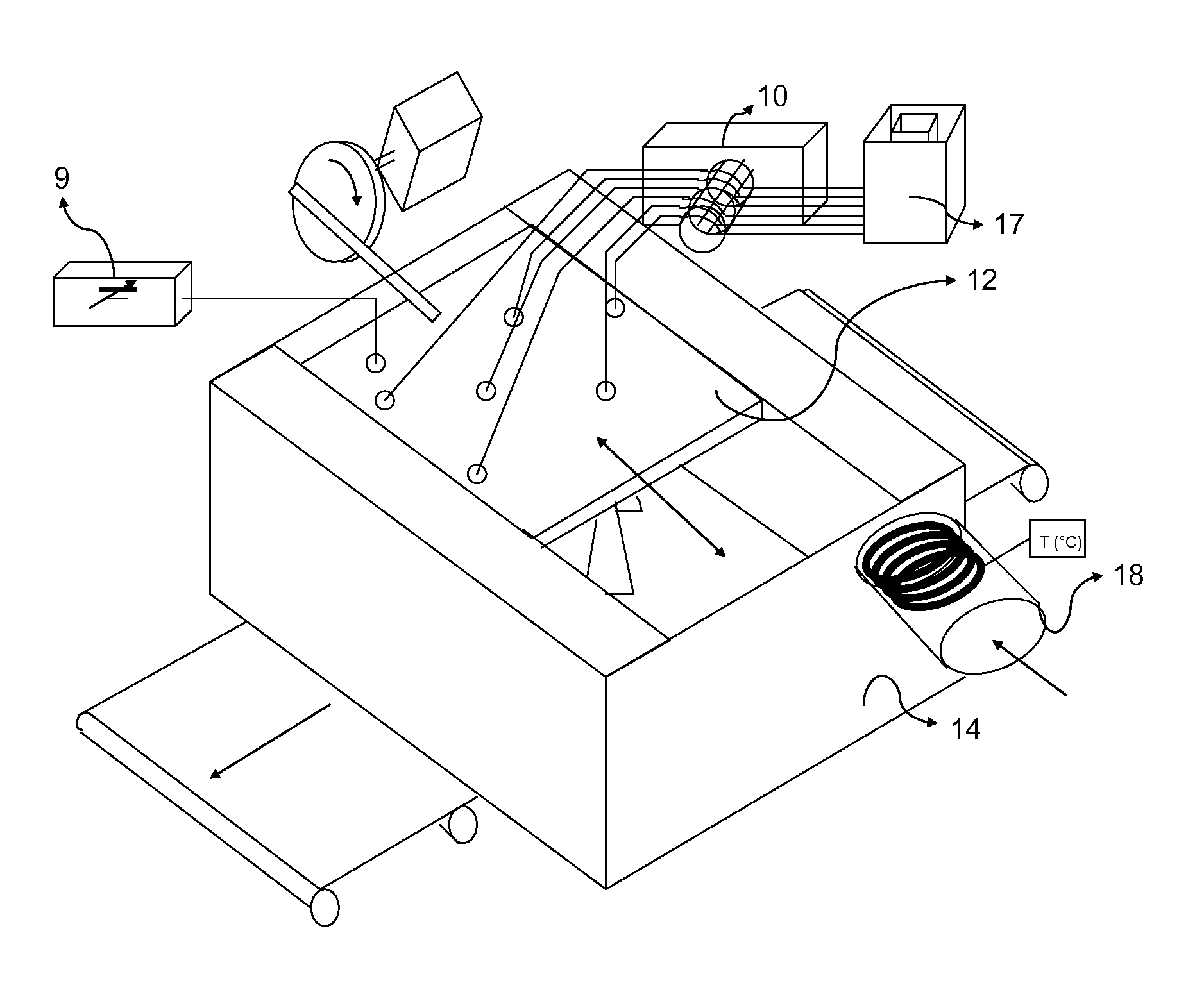Nanofibrous structures and their use in dental applications
a technology of nanofibrous and nanofibrous, applied in the field of nanofibrous structure, can solve the problems of not disclosing not being able to obtain the large surface area required for many applications in an economic feasible way, and not being able to disclose the means to achieve the production of nanofibrous structure, etc., to achieve uniform thickness, high porosity, and large width
- Summary
- Abstract
- Description
- Claims
- Application Information
AI Technical Summary
Benefits of technology
Problems solved by technology
Method used
Image
Examples
example 1
[0180]Polyethylene oxide (PEO) with molecular weight of 300.000 g mol−1 is dissolved in water to obtain a solution of 12% PEO. The solution is pumped to a set of needles with a multitude of multichannel peristaltic pumps, with a flow rate of 10 mL h−1 per needle. In the spinneret an electrical field of about 800 V cm−1 is applied over the upper and lower element in order to allow electrospinning of the polymer solution. Temperature control was performed at 298 K. In one setup 3 needles were used which were positioned at a distance of 2 mm (FIG. 6); in another setup the needles were positioned 6 cm from each other (FIG. 7). In the first setup the nanofibrous structures are less clear and have reduced porosity. With 3 needles a nanofibrous structure production rate of about 0.4 m h−1 was obtained over a width of 60 cm, having a uniform thickness of 0.44±0.02 mm.
example 2
[0181]Polyester amide (PEA) with molecular weight of about 20.000 g mol−1 is dissolved in chloroform to obtain a solution of 25% PEA. The solution is pumped to a set of needles with a multitude of multichannel peristaltic pumps, with a flow rate of 15 mL h−1 per needle. In the spinneret an electrical field of about 1000 V cm−1 is applied over the upper and lower element in order to allow electrospinning of the polymer solution. Temperature control was performed at 298 K. In one setup 3 needles were used which were positioned at a distance of 2 mm (FIG. 8); in another setup the needles were positioned 6 cm from each other (FIG. 9). With 3 needles a nanofibrous structure production rate of about 0.5 m h−1 was obtained over a width of 60 cm, having a uniform thickness of 0.50±0.02 mm.
example 3
[0182]Cellulose acetate (CA) with molecular weight of 30.000 g mol−1 is dissolved in cyclohexanol to obtain a solution of 8% CA. The solution is pumped to a set of needles with a multitude of multichannel peristaltic pumps, with a flow rate of 10 mL h−1 per needle. In the spinneret an electrical field of about 1100 V cm−1 is applied over the upper and lower element in order to allow electrospinning of the polymer solution. Temperature control was performed at 298 K. In one setup 3 needles were used which were positioned at a distance of 2 mm; in another setup the needles were positioned 6 cm from each other (FIG. 10). For the first setup no nanofibrous structure was obtained. With 3 needles a nanofibrous structure production rate of about 0.3 m h−1 was obtained over a width of 60 cm, having a uniform thickness of 0.40±0.02 mm.
PUM
| Property | Measurement | Unit |
|---|---|---|
| distance | aaaaa | aaaaa |
| distance | aaaaa | aaaaa |
| porosity | aaaaa | aaaaa |
Abstract
Description
Claims
Application Information
 Login to View More
Login to View More - R&D
- Intellectual Property
- Life Sciences
- Materials
- Tech Scout
- Unparalleled Data Quality
- Higher Quality Content
- 60% Fewer Hallucinations
Browse by: Latest US Patents, China's latest patents, Technical Efficacy Thesaurus, Application Domain, Technology Topic, Popular Technical Reports.
© 2025 PatSnap. All rights reserved.Legal|Privacy policy|Modern Slavery Act Transparency Statement|Sitemap|About US| Contact US: help@patsnap.com



